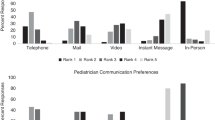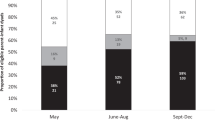Abstract
Objective:
Mobile communication with the medical-care team has the potential to decrease stress among parents of infants admitted to the neonatal intensive care unit (NICU). We assessed mobile use and communication preferences in a population of urban minority NICU mothers.
Study Design:
A 30-question English language survey was administered to mothers of NICU patients.
Results:
The survey was completed by 217 mothers, 75% were Black, and 75% reported annual household income below $20 000. Only 56% had a computer with Internet access at home, but 79% used smartphones. Most (79%) have searched the Internet for health information in the past year. Receiving electronic messages about their babies was viewed favorably, and text messaging was the preferred platform. The majority of mothers felt electronic messaging would improve communication but should not replace verbal communication.
Conclusion:
Mobile communication is used widely in this population of NICU mothers and could potentially improve provider–parent communication and reduce parental stress.
This is a preview of subscription content, access via your institution
Access options
Subscribe to this journal
Receive 12 print issues and online access
$259.00 per year
only $21.58 per issue
Buy this article
- Purchase on Springer Link
- Instant access to full article PDF
Prices may be subject to local taxes which are calculated during checkout
Similar content being viewed by others
References
Vanderbilt D, Gleason MM . Mental health concerns of the premature infant through the lifespan. Pediatr Clin North Am 2011; 58 (4): 815–832 ix.
Lawhon G . Facilitation of parenting the premature infant within the newborn intensive care unit. J Perinat Neonatal Nurs 2002; 16 (1): 71–82.
Deters FG, Mehl MR . Does posting facebook status updates increase or decrease loneliness? an online social networking experiment. Soc Psychol Personal Sci 2013; 4 (5):579–586.
Gonzales AL, Hancock JT . Mirror, mirror on my Facebook wall: effects of exposure to Facebook on self-esteem. Cyberpsychol Behav Soc Netw 2011; 14 (1-2): 79–83.
Drozd F, Raeder S, Kraft P, Bjorkli CA . Multilevel growth curve analyses of treatment effects of a web-based intervention for stress reduction: randomized controlled trial. J Med Internet Res 2013; 15 (4): e84.
March of Dimes Premature Birth Report Card Tennessee. 2015, Available at: http://www.marchofdimes.org/peristats/pdflib/998/premature-birth-report-card-Tennessee.pdf (cited 21 January 2016).
Berns SD, Boyle MD, Popper B, Gooding JS,Preemie Health Coalition. Results of the premature birth national need-gap study. J Perinatol 2007; 27 (Suppl 2):S38–S44.
Craig JW, Glick C, Phillips R, Hall SL, Smith J, Browne J . Recommendations for involving the family in developmental care of the NICU baby. J Perinatol 2015; 35 (Suppl 1): S5–S8.
Muller-Nix C, Forcada-Guex M, Pierrehumbert B, Jaunin L, Borghini A, Ansermet F . Prematurity, maternal stress and mother-child interactions. Early Hum Dev 2004; 79 (2): 145–158.
Gonya J, Nelin LD . Factors associated with maternal visitation and participation in skin-to-skin care in an all referral level IIIc NICU. Acta Paediatr 2013; 102 (2): e53–e56.
Latva R, Lehtonen L, Salmelin RK, Tamminen T . Visiting less than every day: a marker for later behavioral problems in Finnish preterm infants. Arch Pediatr Adolesc Med 2004; 158 (12): 1153–1157.
Weiss S, Goldlust E, Vaucher YE . Improving parent satisfaction: an intervention to increase neonatal parent-provider communication. J Perinatol 2010; 30 (6): 425–430.
Cooper LG, Gooding JS, Gallagher J, Sternesky L, Ledsky R, Berns SD . Impact of a family-centered care initiative on NICU care, staff and families. J Perinatol 2007; 27 (Suppl 2): S32–S37.
Moore KA, Coker K, DuBuisson AB, Swett B, Edwards WH . Implementing potentially better practices for improving family-centered care in neonatal intensive care units: successes and challenges. Pediatrics 2003; 111 (4 Pt 2): e450–e460.
Gray JE, Safran C, Davis RB, Pompilio-Weitzner G, Stewart JE, Zaccagnini L et al. Baby CareLink: using the internet and telemedicine to improve care for high-risk infants. Pediatrics 2000; 106 (6): 1318–1324.
Rhoads SJ, Green A, Gauss CH, Mitchell A, Pate B . Web camera use of mothers and fathers when viewing their hospitalized neonate. Adv Neonatal Care 2015; 15 (6): 440–446.
Rhoads SJ, Green AL, Lewis SD, Rakes L . Challenges of implementation of a web-camera system in the neonatal intensive care unit. Neonatal Netw 2012; 31 (4): 223–228.
Epstein EG, Sherman J, Blackman A, Sinkin RA . Testing the feasibility of skype and facetime updates with parents in the neonatal intensive care unit. Am J Crit Care 2015; 24 (4): 290–296.
Koh TH, Butow PN, Coory M, Budge D, Collie LA, Whitehall J et al. Provision of taped conversations with neonatologists to mothers of babies in intensive care: randomised controlled trial. BMJ 2007; 334 (7583): 28.
Koh TH . Smartphones improve communication with parents in NICU. Lancet 2013; 381 (9866): 535–536.
Smith A, Page D . U.S. Smartphone Use in 2015. Pew Research Center: Washington, 2015.
Irizarry T, DeVito Dabbs A, Curran CR . Patient portals and patient engagement: a state of the science review. J Med Internet Res 2015; 17 (6): e148.
The Joint Commission. Update: Texting Orders. Joint Commission Perspectives, May 2016, Volume 36, Issue 5. Available at: https://www.jointcommission.org/assets/1/6/Update_Texting_Orders.pdf (cited 19 June 2016).
Acknowledgements
We thank Treva Rutherford, LMSW, Chundra Harris, LMSW, Shandrian Guinn, LMSW and Morganne Austin for their assistance with data collection. This study received no internal or external funding.
Author information
Authors and Affiliations
Corresponding author
Ethics declarations
Competing interests
WMF receives consulting fee from the American Academy of Pediatrics. The remaining authors declare no conflict of interest.
Additional information
Supplementary Information accompanies the paper on the Journal of Perinatology website
Supplementary information
Rights and permissions
About this article
Cite this article
Weems, M., Graetz, I., Lan, R. et al. Electronic communication preferences among mothers in the neonatal intensive care unit. J Perinatol 36, 997–1000 (2016). https://doi.org/10.1038/jp.2016.125
Received:
Revised:
Accepted:
Published:
Issue Date:
DOI: https://doi.org/10.1038/jp.2016.125



